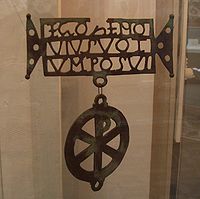
Biertan Donarium
Encyclopedia

Christian
A Christian is a person who adheres to Christianity, an Abrahamic, monotheistic religion based on the life and teachings of Jesus of Nazareth as recorded in the Canonical gospels and the letters of the New Testament...
votive object found near the town of Biertan
Biertan
Biertan is a commune in central Romania, in the north of the Sibiu County, 80 km north of Sibiu and 15 km east of Mediaş. Biertan is one of the most important Saxon villages with fortified churches in Transylvania, having been on the list of UNESCO World Heritage Sites since 1993...
, in Transylvania
Transylvania
Transylvania is a historical region in the central part of Romania. Bounded on the east and south by the Carpathian mountain range, historical Transylvania extended in the west to the Apuseni Mountains; however, the term sometimes encompasses not only Transylvania proper, but also the historical...
, Romania
Romania
Romania is a country located at the crossroads of Central and Southeastern Europe, on the Lower Danube, within and outside the Carpathian arch, bordering on the Black Sea...
.
Made out of bronze in the shape of a Labarum
Labarum
The labarum was a vexillum that displayed the "Chi-Rho" symbol ☧, formed from the first two Greek letters of the word "Christ" — Chi and Rho . It was used by the Roman emperor Constantine I...
, it has the Latin
Latin
Latin is an Italic language originally spoken in Latium and Ancient Rome. It, along with most European languages, is a descendant of the ancient Proto-Indo-European language. Although it is considered a dead language, a number of scholars and members of the Christian clergy speak it fluently, and...
text EGO ZENOVIUS VOTUM POSVI, which can be approximatively translated as "I, Zenovius, offered this gift".
It was found in 1775 in the Chimdru forest, about 5 km south of Biertan and it was part of the collections of Baron Samuel von Brukenthal
Samuel von Brukenthal
Samuel von Brukenthal was the Habsburg governor of the Grand Principality of Transylvania between July 6, 1774 and January 9, 1787...
, nowadays being part of the exhibits of the Brukenthal National Museum
Brukenthal National Museum
The Brukenthal National Museum is a museum, erected in the late of 15th century in Sibiu, Romania, housed in the palace of Samuel von Brukenthal — who was Habsburg governor of Transylvania and who established its first collections around 1790...
.
This donarium was used as an argument for the existence of a Latin-speaking Christian population in Dacia
Dacia
In ancient geography, especially in Roman sources, Dacia was the land inhabited by the Dacians or Getae as they were known by the Greeks—the branch of the Thracians north of the Haemus range...
(possibly the ancestors of Romanians
Romanians
The Romanians are an ethnic group native to Romania, who speak Romanian; they are the majority inhabitants of Romania....
) following the Aurelian Retreat.

